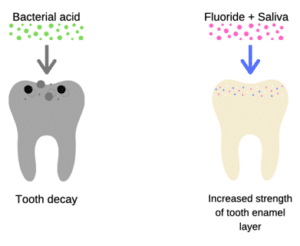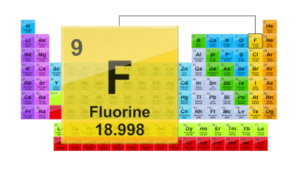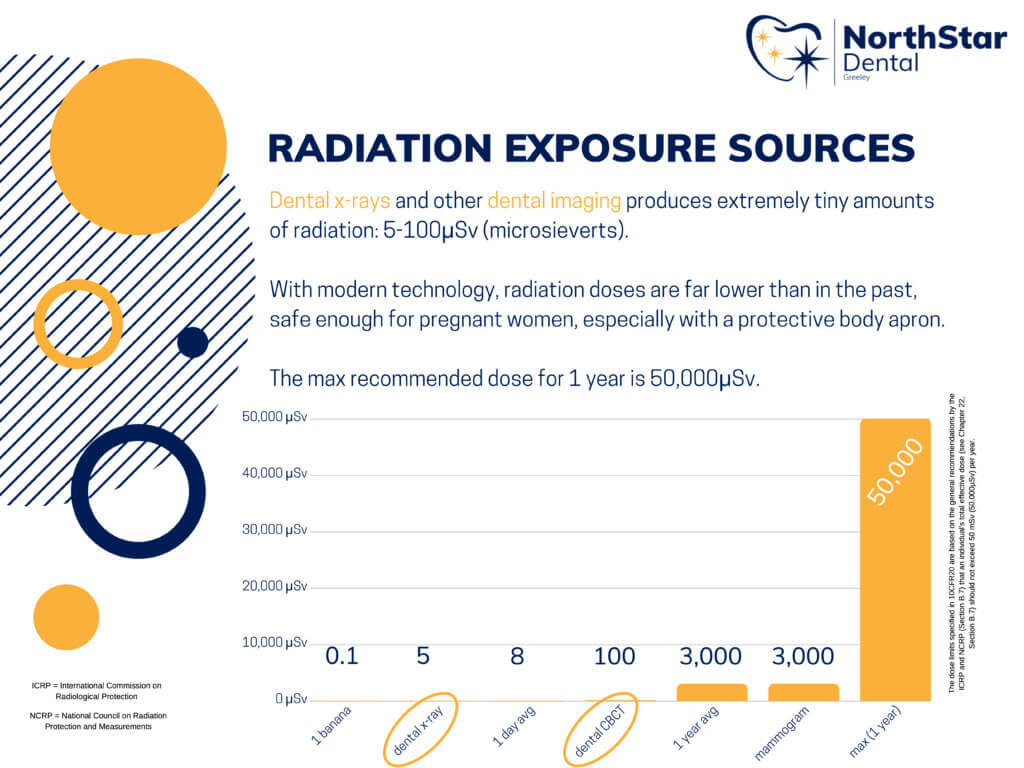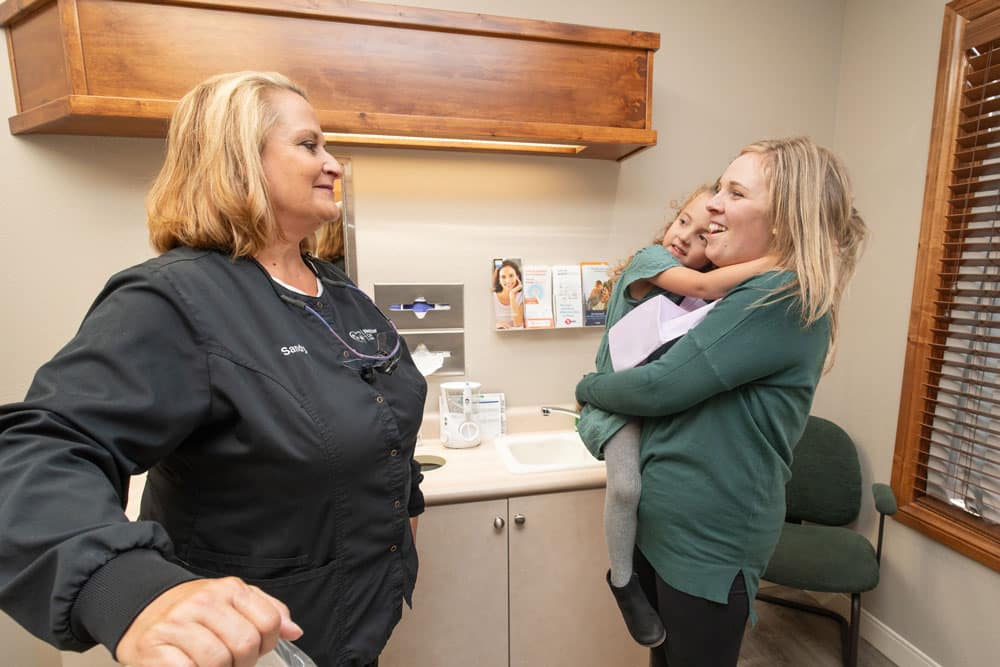F.A.Q.
Frequently Asked Questions
Common Dental Questions
Bacteria + Sugar = Acid, and Acid dissolves your tooth!
- Bacteria (AKA: plaque, germs) are alive in your mouth
- This bacteria eats the sugar that you consume and uses it as fuel to make more bacteria and form bacteria colonies
- After bacteria has processed the sugar, the bacteria secrete acid onto your teeth for about 20 minutes
- Our saliva neutralizes small amounts of acid. If bacteria produce too much acid for too long, it slowly dissolves the tooth
- Eventually, the acid dissolves into the tooth and bacteria starts to live in the walls of the tooth itself. This is what we call a cavity
- This is why we drill out the decayed tooth structure and place a filling in that space before it gets worse
- If a cavity continues to form without being treated early, it eventually reaches the pulp and may require more treatment like a crown or a root canal

The first line of defense against a cavity is brushing and flossing (to remove bacteria) and limiting how often you have sugar (so the bacteria can’t make acid).
The second line of defense is typically a filling, but a deep cavity may require a crown and a root canal to clean out all of the bacteria.
How can you prevent cavities? Visit how can I prevent dental problems to find out!
- Bacteria (AKA: plaque, germs) are alive in your mouth
- This bacteria processes the sugar that you eat and drink and uses it as fuel to make more bacteria and form bacteria colonies
- Your body tries to kill this bacteria and it uses your natural blood vessels to send your immune system fighters to kill off the bacteria
- As your blood vessels fill up with these extra cells, the gums become red and swollen and can bleed very easily (gingivitis) – this can be reversed with good hygiene
- If you don’t clean this bacteria out yourself, then it will start to invade deep into the gum tissue and eventually reach the bone around the tooth.
- The bacteria then form a hard structure on the tooth called tarter, or calculus, that is impossible to remove at home
- As the bacteria invades deeper and deeper, it erodes the bone away and becomes even harder to clean out (periodontitis)
- In order to remove the bacteria and prevent further destruction, periodontal therapy is advised
Good news! You are in control of your dental destiny.
If you’ve already read our articles on cavities and gum and bone disease you know that dental problems are caused by two things:
Bacteria and Sugar
The goal of any good at home regiment is to remove bacteria and limit sugar as much as possible.
- Flossing – This cleans out bacteria living between the teeth. Wrap the floss in the shape of a “C” around your teeth and scrub up and down on the side of the tooth, being careful not to shove the floss aggressively into your gums. When you’re done, slide your fingers across the floss so you put a new, clean piece into the next gap. You may use 1 foot or more of floss each time!
- Brushing – Along with flossing, brushing helps remove the bacteria in your mouth. Brush your teeth for 2 minutes, twice per day.
- Set a timer for 2 minutes
- Watch yourself brush in the mirror to make sure you get all surfaces of all your teeth
- Don’t do other things when you brush, just focus on cleaning your mouth completely until your teeth are nice and smooth!
- Saliva – Your saliva contains beneficial molecules that can help neutralize bacterial acid! Drinking lots of water helps your saliva flow and increases the beneficial effects of saliva.
- Things that decrease saliva
- Natural aging decreases saliva flow over time – this is why you may start to experience more cavities later in life
- Medications – many medications cause dry mouth
- Dry climate – Living in dry areas means that you will lose more body water than someone living in a humid environment, especially while sleeping when you saliva flow is already low!
- Things that decrease saliva
- Limit Time Exposure to Sugar (see chart at bottom of page) – Bacteria can only make acid for about 20 minutes after you consume sugar. You should focus on limiting how often you consume sugar in a day! If you consume sugar for 3 hours, that is far worse for your teeth than consuming sugar for 1 hour. Check the Nutrition Facts label on the foods you eat!
- Common sources of sugar:
- Soda, energy drinks, sweet tea
- Mints and candy
- Coffee (only if you add sugar!)
- Processed snack foods
- Bread and other grains, as well as fruit, also contain a type of sugar… so be careful snacking on those, too!
- Common sources of sugar:
- Fluoride – Fluoride is in lots of dental products including toothpaste and some mouthwashes. Fluoride helps repair enamel and can slow down and potentially stop a cavity as long as it hasn’t broken through the enamel. This is why we recommend fluoride varnish at all of your routine cleaning appointments! Fluoride only works when bacterial acid production is low, so sugar and bacteria must be under control for fluoride to be effective. If you want, you can add a fluoride mouthwash after you floss and brush before you go to bed at night.
A brief history of Fluoride:
Fluoride’s dental benefits were discovered on accident in 1901 in Colorado Springs by Dr. Frederick McKay. He noticed that children in the community had severe brown stains on their teeth but their rate of tooth decay was extremely low.
After 3 decades of research into the cause of the staining, it was discovered the extreme levels of natural fluoride in the water was causing both the brown stains and the cavity-resistant teeth.
In the 1950’s, cities began to dial in specific levels of fluoride into the water. The levels were high enough to make teeth more resistant to decay, but low enough not to cause brown staining.
The HHS department finally settled on a concentration of 0.7ppm (parts per million) of fluoride for optimal benefit without tooth staining. Greeley participates in this program and the local water supply is exactly 0.7ppm!
The addition of fluoride into the public water supply is considered one of the top 10 most successful public health initiatives in history by the CDC because of the dramatic decrease in tooth decay after the addition of fluoride to the water supply.
https://www.nidcr.nih.gov/health-info/fluoride/the-story-of-fluoridation
How Fluoride works:
Fluoride is the combination of the natural element Fluorine (see below) and some other element, like Sodium to stabilize it.
When fluoride comes in contact with saliva, it combines with the calcium and phosphorus naturally in your saliva and bonds to tooth structure, increasing its hardness making it more resistant to acid attacks by bacteria. Fluoride also directly inhibits bacteria from functioning properly, thus decreasing bacterial acid production in the first place!
This is why we always recommend fluoride varnish after your dental cleaning appointments. Your teeth are never cleaner than when they are professionally cleaned and this is the optimal time to apply additional fluoride which has been showed to increase enamel strength by over 60% because it’s the most concentrated and adherent type of fluoride that exists. Because fluoride adds a protective layer to the teeth, it also helps decrease tooth sensitivity.
https://www.webmd.com/oral-health/guide/fluoride-treatment


How do I know I’m not getting too much Fluoride?
The concentration of fluoride in properly administered topical fluoride, toothpastes and mouthwashes, and in regulated water supplies is far too low to cause any measurable effects on the human body. Acute fluoride overdoses occur in areas where some sort of fluoride contamination has entered the water supply or the environment and is not of concern in developed nations like the United States.
Is Fluoride safe for my child?
Because children are growing and weigh far less than adults, we always recommend child versions of all dental products until the child is at least 6 years of age. This will help prevent the child from accidently using far too much adult toothpaste, which has higher concentrations.
The fear with children is not the fluoride itself, but accidental unsupervised consumption of fluoride containing products (like a child squirting a tube of toothpaste in their mouth or drinking fluoride mouthwash, for example).
Fluoride varnishes are safe for kids!
American Academy of Pediatrics: https://www.healthychildren.org/English/healthy-living/oral-health/Pages/Fluoride-Varnish-What-Parents-Need-to-Know.aspx
Who can benefit from Fluoride treatment?
Because fluoride has a direct effect on exposed tooth structure, and oral bacteria, fluoride is recommended throughout our lives as an additive in toothpastes, water, and varnish treatments at the dentist.
There are particular groups that are considered to be at “high risk” for cavities and stand to have the greatest benefit from additional fluoride:
- Patients with decreased salivary flow and dry mouth
- Our saliva naturally slows with age
- Saliva flow can decrease with certain medications as well
- Patients with advanced gum disease
- More tooth structure is exposed as the gums and bone decay, making the tooth vulnerable to cavities on the roots
- Patients with moderate to large amounts of dental work
- As more work is done, bacteria has more places to hide and fluoride helps strengthen these vulnerable areas to prevent the tooth from breaking down around the work that has been done
- Patients with a history of cavities
- Patients with a history of tooth decay benefit from fluoride because fluoride will help slow and stop the progression of microscopic cavities, as long as bacteria and sugar are under control
- Patients with sensitivity
- Fluoride creates a protective layer on the tooth to make teeth stronger, but it also helps protect the tooth from things that can make them sensitive to hot and cold temperature, sweets, and even sugar
Dental x-rays are very safe, even for pregnant women.
Dental x-rays use a micro-dose of radiation to penetrate the structures of your mouth to give us a picture of what lies below the surface.
A typical dental x-ray produces about 5 μSv of radiation – the same amount of radiation you receive during a 1-hour airplane flight.
For comparison, the typical person is exposed to about 3000 μSv of radiation per year just going about their normal daily life.
So the good news is that dental x-rays only expose you to an extremely tiny fraction of the radiation that is naturally emitted from the sun and the earth around us.
Despite this low radiation dose, we still take precautions to limit radiation exposure by placing a lead apron over the rest of your body so that radiation is only applied to the area we are trying to see.
For pregnant women: https://www.ada.org/member-center/oral-health-topics/pregnancy


